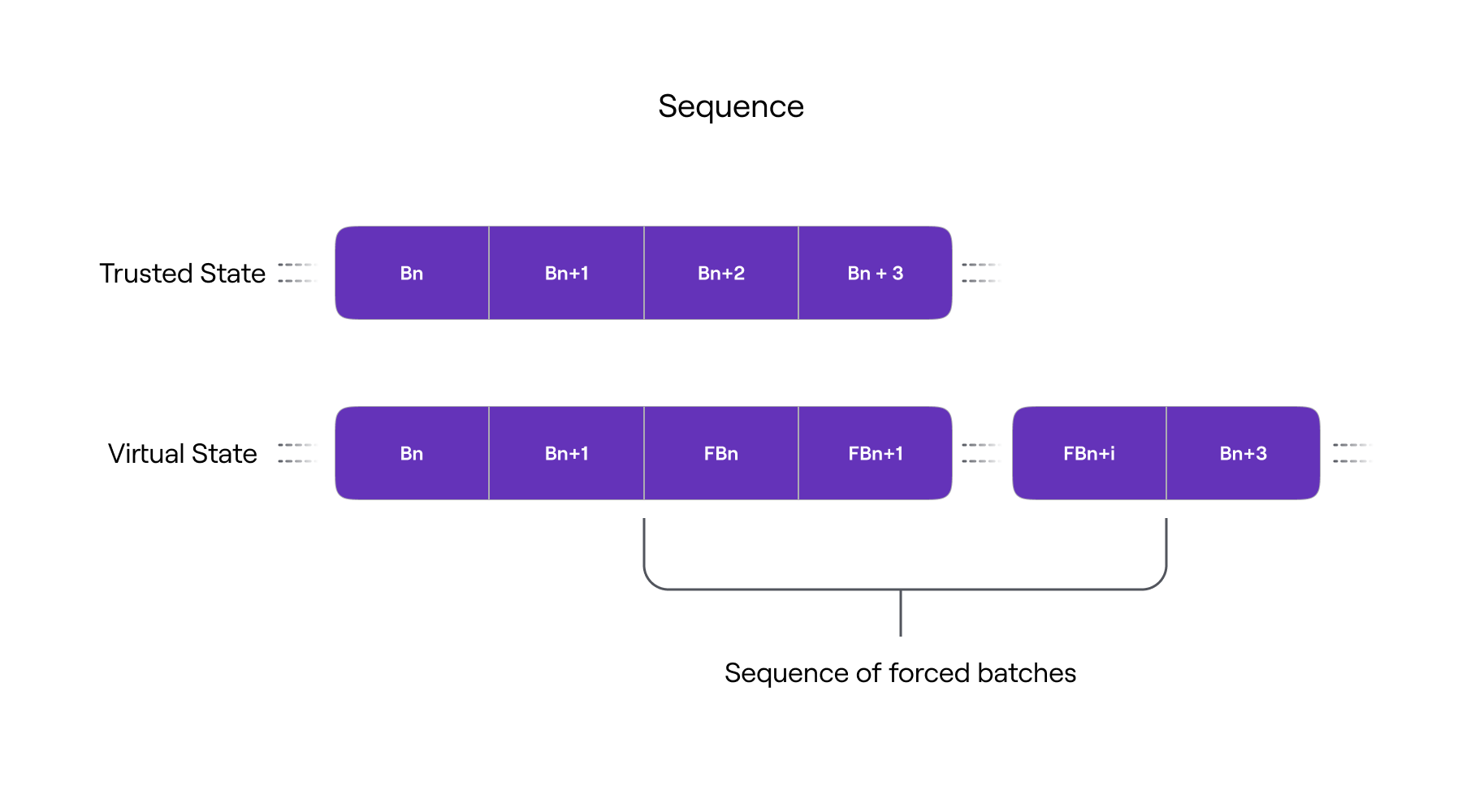Force batches
Users must rely on a Trusted Sequencer for their transactions to be executed in the L2. However, users can include their transactions in a forced batch if they are unable to execute them through the Trusted Sequencer.
A forced batch is a collection of L2 transactions that users can commit to L1 to publicly declare their intent to execute those transactions.

The PolygonZkEVM.sol contract has a forcedBatches mapping, as shown in the above figure, in which users can submit transaction batches to be forced. The forcedBatches mapping serves as an immutable notice board where forced batches are timestamped and published before being included in a sequence.
// ForceBatchNum --> hashedForcedBatchData
mapping(uint64 => bytes32) public forcedBatches;
Caution
The Trusted Sequencer will include these forced batches in future sequences to maintain its status as a trusted entity. Otherwise, users will be able to demonstrate that they are being censored, and the Trusted Sequencer’s trusted status will be revoked.
Although the Trusted Sequencer is incentivized to sequence the forced batches published in the forcedBatches mapping, this does not guarantee finality of the transactions’ execution in those batches.
In order to ensure finality in the case of Trusted Sequencer’s malfunction, the L1 PolygonZkEVM.sol contract has an alternative batch sequencing function called sequenceForceBatches. This function allows anyone to sequence forced batches that have been published for a time period, specified by the public constant forceBatchTimeout, yet they have not been sequenced. The timeout is set to 5 days.
Any user can publish a batch to be forced by directly calling forceBatch function:
function sequenceForceBatches(
ForcedBatchData[] memory batches
) public ifNotEmergencyState isForceBatchAllowed
function sequenceForceBatches(
BatchData[] calldata batches
) external virtual isSenderAllowedToForceBatches
In order to successfully publish forced batch to the forcedBatches mapping, the following conditions must be met, otherwise the transaction will revert;
- The contract must not be in emergency state,
- The force batches must be allowed,
- The
maticAmountargument must be higher than the MATIC fee per batch. It is the maximum amount of MATIC tokens the user is willing to pay as a forced batch publication fee. The fee for publishing a forced batch is the same as the fee for sequencing, and it is therefore set in thebatchFeestorage variable. Since the fee is paid when a forced batch is published, it will not be paid again when the batch is sequenced. - The length of the transactions byte array must be less than the value of
MAX_TRANSACTIONS_BYTE_LENGTHconstant (which is set at 120000).
The forced batch is entered in forcedBatches mapping keyed by its force batch index.
struct ForcedBatchData {
bytes transactions;
bytes32 globalExitRoot;
uint64 minForcedTimestamp;
}
The lastForceBatch storage variable, which is incremented for each forced batch published, serves as a forced batch counter and thus provides a specific index number. The value entered is a hash digest of the ABI-encoded packed struct fields from the lastForceBatch.
keccak256(
abi.encodePacked(
keccak256(bytes transactions),
bytes32 globalExitRoot,
unint64 minTimestamp
)
);
Storage slots (mapping entries) are only used to store a commitment of the forced batch for storage usage optimization reasons. Data availability is ensured because it can be recovered from transaction calldata.
The contract sets the minTimestamp to the L1 block timestamp, at which point the forced batch is published.
In the extremely unlikely event that the Trusted Sequencer fails, any user can use the sequenceForceBatches function to sequence forced batches:
function sequenceForceBatches(
ForcedBatchData[] memory batches
) public ifNotEmergencyState isForceBatchAllowed
The sequenceForceBatches function is similar to the sequenceBatches function, but it can be called by anyone if batch forcing is enabled.
The sequenceForceBatches function determines whether each batch in the submitted sequence has been published to the forcedBatches mapping for a period of time greater than the forceBatchTimeout.
Because the MATIC batch fee was paid at the time of publication, it will not be required to be paid again.
If the sequence of forced batches meets all of the sequence conditions, it will be added to the sequencedBatches mapping as a regular one. As a result, a sequenceForceBatches event will be generated.
event SequenceForceBatches(uint64 indexed numBatch);
Note that since the sequences of forced batches sequenced using the sequenceForceBatches function will never be in a trusted state, there will be a divergence between the node’s local trusted L2 State and the virtual L2 State committed in the L1 PolygonZkEVM.sol contract.
This situation has been detected and handled by the node software. It will reorganise its local L2 State instance based on the L2 State retrieved from L1. The diagram below depicts the distinctions between trusted and virtual L2 states that occur when a forced batch sequence is executed.
